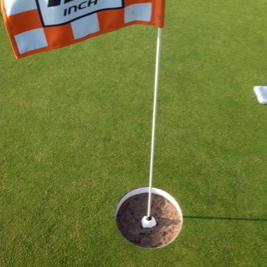Another venue more than trebles the size of its hole cups
Related Articles
Norwood Park Golf Centre in Nottinghamshire has become the latest golf club to use giant hole cups to attract juniors and beginners to the game.
Instead of using the traditional four and a quarter inch diameter hole cup for golfers, the venue has installed holes with 15 inch diameters. The theory is that larger hole cups make the game less difficult and more fun for juniors and beginners, and therefore make it more likely that they continue with the activity.
“The par three course was re-designed to incorporate shorter EZ tees and the 15 inch holes positioned on the greens away from the normal holes,” said club spokesman Rob Macey.
“It gives the players more choice and is ideal for beginners and juniors wanting to make the transition from the driving range on to the course quicker and without making it too difficult.
“It really has been very popular, offering both variety and fun for all the family and many national governing bodies have supported such initiatives to help golf appeal to all.”
“Norwood Park has shown to be one of the more proactive clubs, they put development at the heart of everything they do,” said sports development officer Matthew Bloor.
Last year Laurence Pithie, Europe’s first ‘Master Greenkeeper’, who sits on Greenkeeping magazine’s distinguished editorial advisory panel, said increasing the size of the holes would attract more golfers and be better for the environment.
“Golf is not as popular as it once was and there needs to be a viable alternative,” he said. “Making golf more fun, more affordable and taking up less time to play has to be the key objectives. Increase the size of the golf hole. This idea is not aimed at replacing the existing hole size on established full length courses, but it could be introduced on ‘entry level’ nine-hole or short-hole courses.”
Pithie listed the benefits that would be gained from increasing the size of the hole.
He said: “Less putts will lead to fewer issues with greens’ quality and performance, the height of cut can be increased to 6mm, which leads to more options of grass species, less turf stress equals lower inputs and healthier turf, reduced need for water, fertilisers and chemicals, less risk of thatch, disease, dry patch, moss, algae, nematodes and so on, reduced need in hole changing frequency, lower requirement for cultural practices, therefore possible savings in some equipment, lower level of maintenance equals lower costs, lower fuel requirements due to lower mechanical inputs, lower amounts of sand dressings required and the ability to develop grasses with lower input requirements.”


























